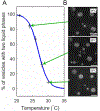Giant Plasma Membrane Vesicles: An Experimental Tool for Probing the Effects of Drugs and Other Conditions on Membrane Domain Stability
- PMID: 29673522
- PMCID: PMC6070695
- DOI: 10.1016/bs.mie.2018.02.007
Giant Plasma Membrane Vesicles: An Experimental Tool for Probing the Effects of Drugs and Other Conditions on Membrane Domain Stability
Abstract
Giant plasma membrane vesicles (GPMVs) are isolated directly from living cells and provide an alternative to vesicles constructed of synthetic or purified lipids as an experimental model system for use in a wide range of assays. GPMVs capture much of the compositional protein and lipid complexity of intact cell plasma membranes, are filled with cytoplasm, and are free from contamination with membranes from internal organelles. GPMVs often exhibit a miscibility transition below the growth temperature of their parent cells. GPMVs labeled with a fluorescent protein or lipid analog appear uniform on the micron-scale when imaged above the miscibility transition temperature, and separate into coexisting liquid domains with differing membrane compositions and physical properties below this temperature. The presence of this miscibility transition in isolated GPMVs suggests that a similar phase-like heterogeneity occurs in intact plasma membranes under growth conditions, albeit on smaller length scales. In this context, GPMVs provide a simple and controlled experimental system to explore how drugs and other environmental conditions alter the composition and stability of phase-like domains in intact cell membranes. This chapter describes methods to generate and isolate GPMVs from adherent mammalian cells and to interrogate their miscibility transition temperatures using fluorescence microscopy.
Keywords: Lipid raft; Liquid-disordered; Liquid-ordered; Miscibility; Phase transition; Plasma membrane; Vesicle.
© 2018 Elsevier Inc. All rights reserved.
Figures






Similar articles
-
Growth Conditions and Cell Cycle Phase Modulate Phase Transition Temperatures in RBL-2H3 Derived Plasma Membrane Vesicles.PLoS One. 2015 Sep 14;10(9):e0137741. doi: 10.1371/journal.pone.0137741. eCollection 2015. PLoS One. 2015. PMID: 26368288 Free PMC article.
-
Elucidating membrane structure and protein behavior using giant plasma membrane vesicles.Nat Protoc. 2012 May 3;7(6):1042-51. doi: 10.1038/nprot.2012.059. Nat Protoc. 2012. PMID: 22555243
-
Live cell plasma membranes do not exhibit a miscibility phase transition over a wide range of temperatures.J Phys Chem B. 2015 Mar 26;119(12):4450-9. doi: 10.1021/jp512839q. Epub 2015 Mar 18. J Phys Chem B. 2015. PMID: 25747462
-
Giant plasma membrane vesicles: models for understanding membrane organization.Curr Top Membr. 2015;75:25-57. doi: 10.1016/bs.ctm.2015.03.009. Epub 2015 Apr 17. Curr Top Membr. 2015. PMID: 26015280 Review.
-
Seeing spots: complex phase behavior in simple membranes.Biochim Biophys Acta. 2005 Dec 30;1746(3):172-85. doi: 10.1016/j.bbamcr.2005.06.010. Epub 2005 Jul 6. Biochim Biophys Acta. 2005. PMID: 16043244 Review.
Cited by
-
The C99 domain of the amyloid precursor protein resides in the disordered membrane phase.J Biol Chem. 2021 Jan-Jun;296:100652. doi: 10.1016/j.jbc.2021.100652. Epub 2021 Apr 9. J Biol Chem. 2021. PMID: 33839158 Free PMC article.
-
Cytotoxic rhamnolipid micelles drive acute virulence in Pseudomonas aeruginosa.Infect Immun. 2024 Mar 12;92(3):e0040723. doi: 10.1128/iai.00407-23. Epub 2024 Feb 23. Infect Immun. 2024. PMID: 38391248 Free PMC article.
-
Forces of Change: Optical Tweezers in Membrane Remodeling Studies.J Membr Biol. 2022 Dec;255(6):677-690. doi: 10.1007/s00232-022-00241-1. Epub 2022 May 26. J Membr Biol. 2022. PMID: 35616705 Review.
-
CaV1.3 channel clusters characterized by live-cell and isolated plasma membrane nanoscopy.Commun Biol. 2024 May 23;7(1):620. doi: 10.1038/s42003-024-06313-3. Commun Biol. 2024. PMID: 38783117 Free PMC article.
-
Temperature dependence of membrane viscosity of ternary lipid GUV with Lo domains.Biophys J. 2025 Mar 4;124(5):818-828. doi: 10.1016/j.bpj.2025.01.024. Epub 2025 Feb 3. Biophys J. 2025. PMID: 39905732 Free PMC article.
References
-
- Allen JA, Halverson-Tamboli RA and Rasenick MM (2007). “Lipid raft microdomains and neurotransmitter signalling.” Nature Reviews Neuroscience 8(2): 128–140. - PubMed
Publication types
MeSH terms
Substances
Grants and funding
LinkOut - more resources
Full Text Sources
Other Literature Sources

